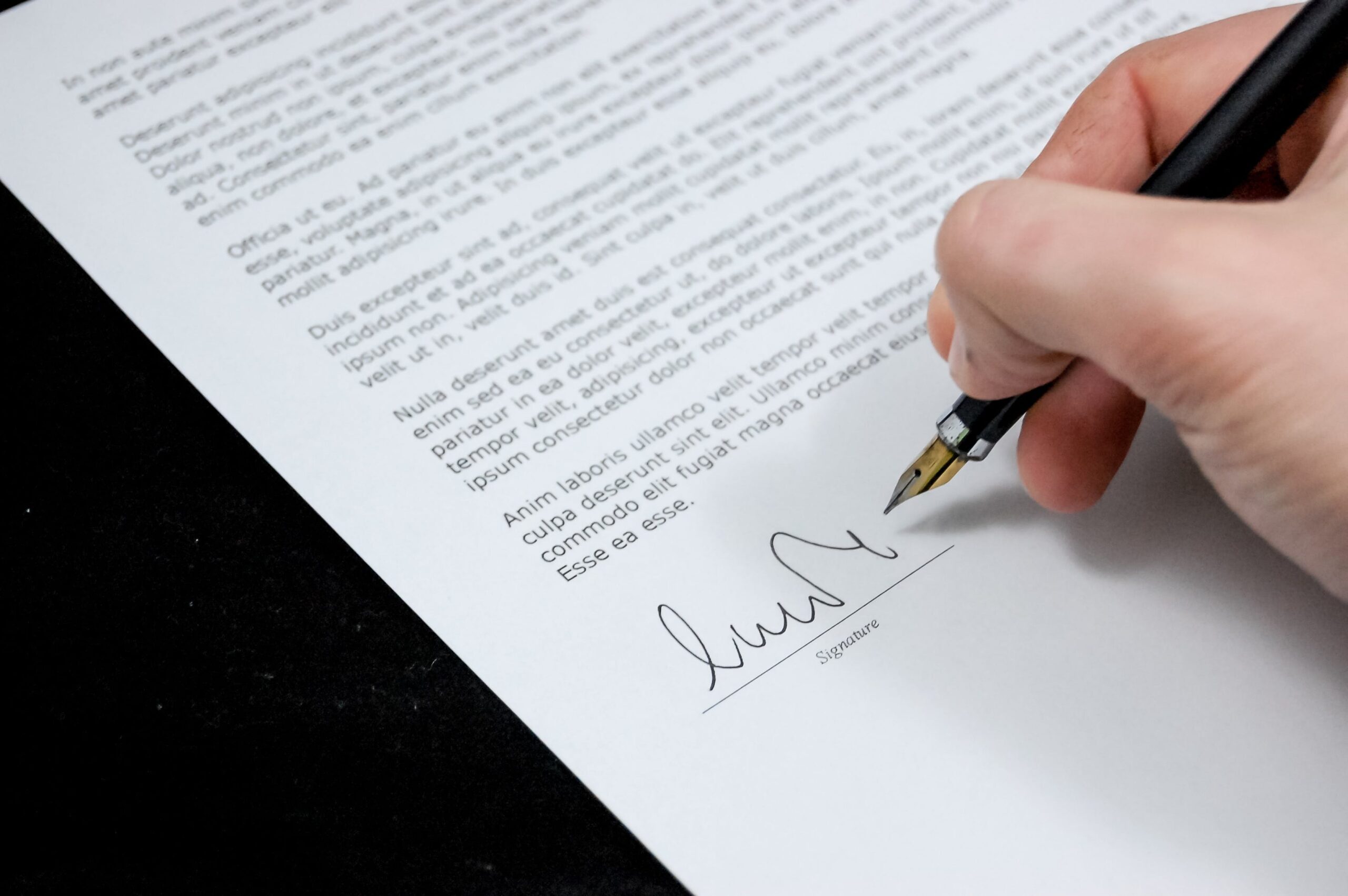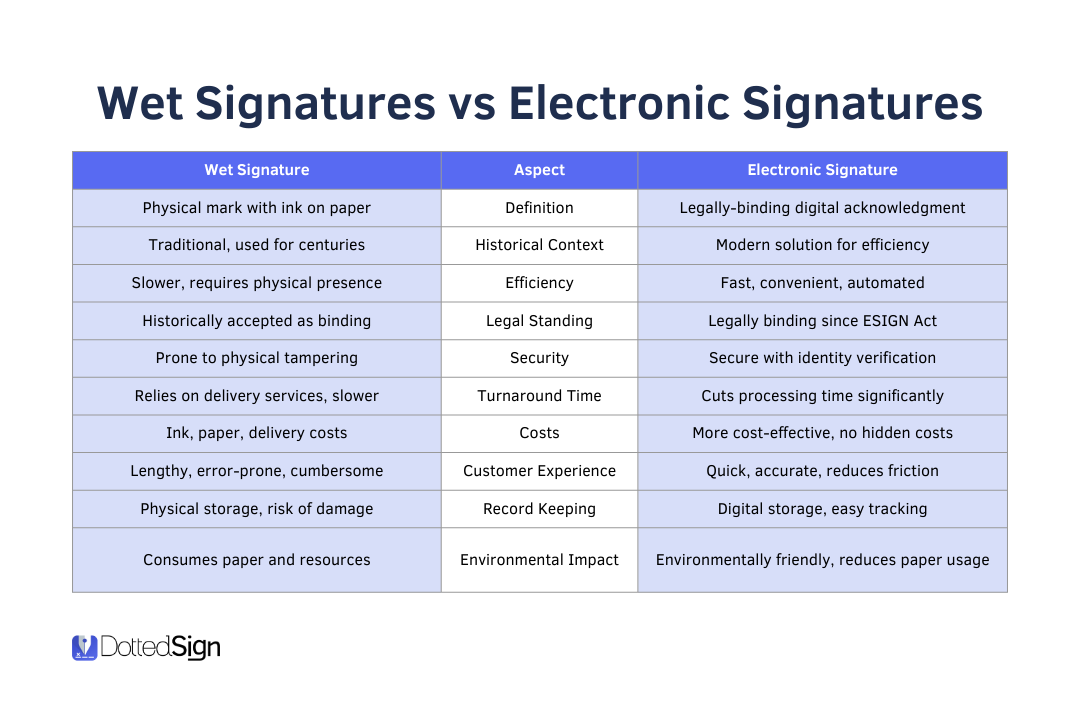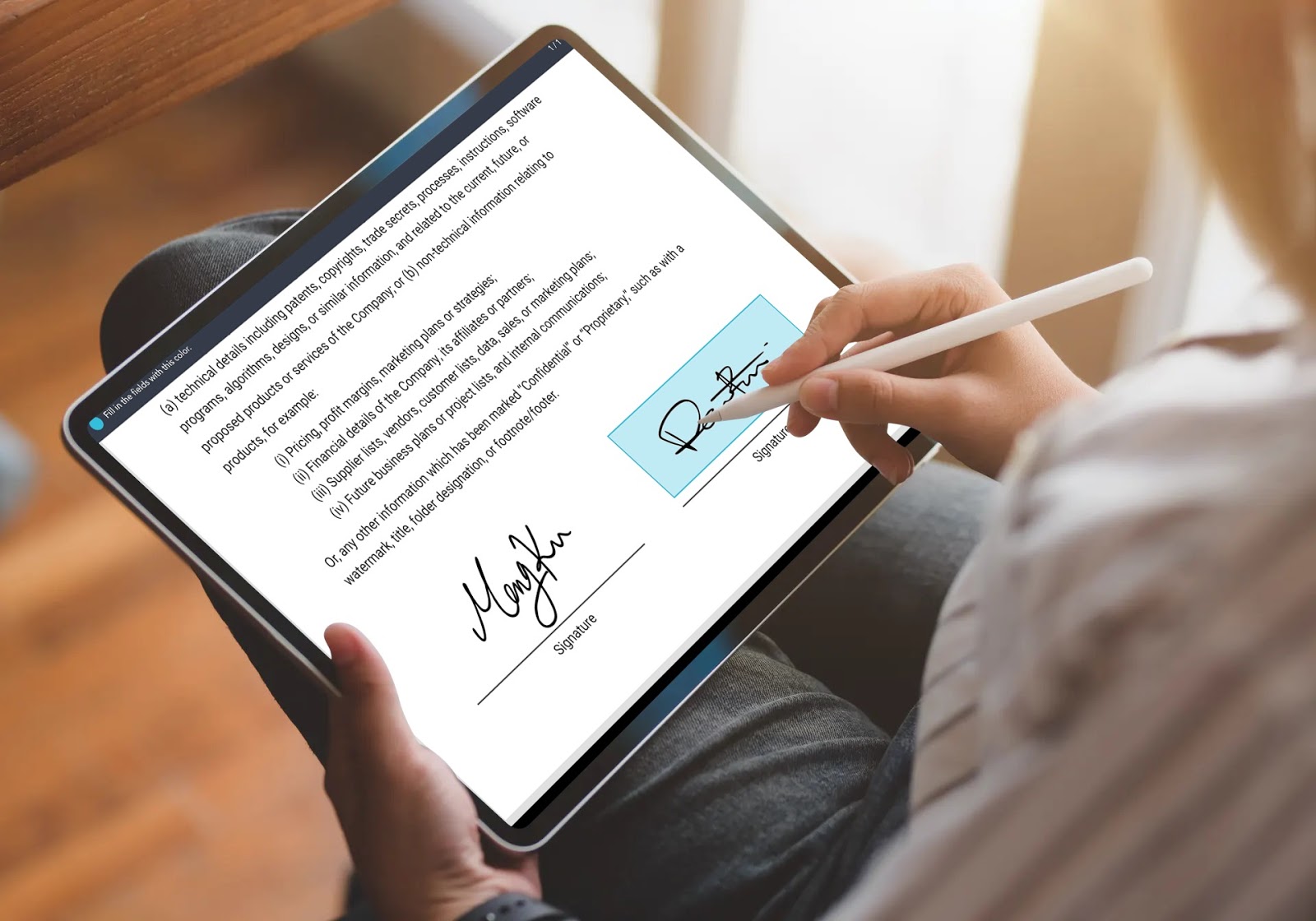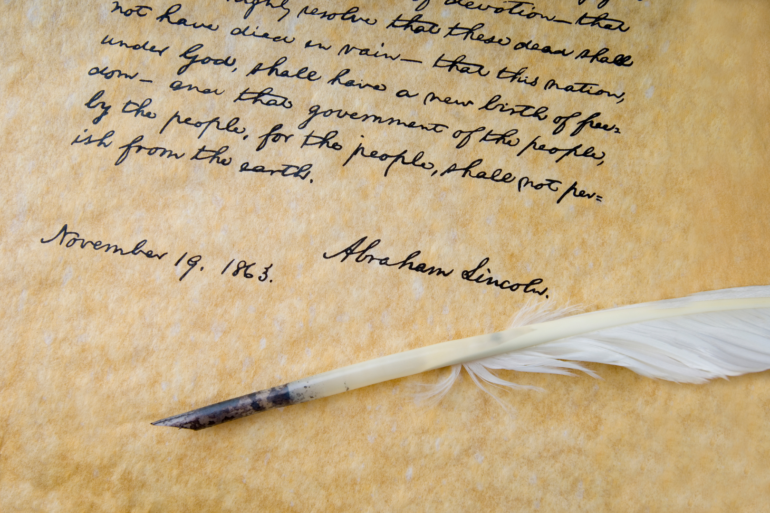Wet Signatures vs. Electronic Signatures — A Deep Dive
Originally published on 27 September 2023. Last updated on 18 August 2025.
If you’ve ever wondered what a wet signature is, or whether a wet signature can be scanned or sent electronically, you’re not alone. These are common questions for businesses navigating between traditional paperwork and modern digital workflows.
In this article, we’ll break down the wet signature meaning, how it differs from electronic and digital signatures, and when a wet signature is still required by law. We’ll also show you how platforms like DottedSign can help manage hybrid signing processes—so you can stay compliant without compromising on speed.
What is a Wet Signature?
A wet signature is a handwritten mark—usually made in ink—used to sign physical paper documents. Also known as a wet ink signature, this traditional method dates back centuries and remains legally required in certain situations today.
From contracts and court filings to real estate transactions and wills, wet signatures have long served as proof of identity, agreement, and intent. They’re called “wet” because the ink needs to dry on the page, whether it’s a name, stamp, seal, or even an “X”.

The History Behind Wet Signatures
Wet signatures have been used for centuries to formalize agreements and establish legal accountability. From royal decrees to the signing of the Declaration of Independence in 1776, the act of putting pen to paper has symbolized trust and intent for generations.
While technology has advanced, some legal systems still uphold wet signatures as the only valid form of consent for certain types of documents—especially those involving government agencies, real estate, or high-risk transactions.
What Is the Wet Signature Rule?
The wet signature rule refers to legal or regulatory guidelines that require a physical, handwritten signature on certain types of documents. These rules exist to ensure authenticity and legal compliance, particularly in areas where digital alternatives have not yet been accepted.
Examples include:
- Wills and trusts
- Real estate deeds
- Divorce and adoption paperwork
- Some government filings
- Notarized documents
In these cases, physical signatures serve as the only legally accepted form of agreement. Even though a wet signature can be scanned and sent electronically, the original document may still need to be retained for legal compliance. If you’re unsure whether a wet signature is required, it’s best to consult local laws or legal counsel.
Pros and Cons of Wet Signatures
While wet signatures have stood the test of time, they’re not without limitations in today’s digital-first environment. Here’s a closer look at the key advantages and drawbacks of using wet ink signatures.
Pros of Wet Signatures
- Universally recognized
Wet signatures have been a standard method of verifying agreements for centuries. In many legal systems, a handwritten signature is still required for specific document types. - Tangible proof of intent
Signing a physical document can feel more official and personal—especially for high-value transactions like wills, property transfers, or notarized contracts. - Widely accepted for regulatory compliance
In some cases, a wet signature is explicitly required by law. For example, certain government documents, real estate deeds, or court filings still need a physical signature.
Cons of Wet Signatures
- Time-consuming and inefficient
Printing, mailing, and scanning documents slow down business processes. A simple approval that could take minutes with an e-signature may take days with a physical one. - Harder to track and manage
Wet signatures lack built-in audit trails or digital timestamps, making them harder to verify or organize at scale. - Security and storage challenges
Physical documents are vulnerable to loss, damage, or unauthorized access. Even if a wet signature is scanned, it must still be stored securely to maintain legal validity. - Not ideal for remote teams
In a hybrid or remote work environment, coordinating handwritten signatures can be frustrating for both internal teams and external clients.
Wet Signatures vs. Electronic and Digital Signatures

What’s the Difference Between Wet, Electronic, and Digital Signatures?
To understand the shift from traditional to digital signing, it’s important to clarify the difference between wet signatures, electronic signatures, and digital signatures.
- A wet signature is a handwritten signature made with ink on paper, a process that has been used for centuries. It’s called “wet” because the ink needs time to dry. (Example: signing a paper contract in person.)
- An electronic signature (or e-signature) is any signature applied digitally, like typing your name, drawing it on a screen, or clicking “I agree.” It is legally binding in many countries when proper authentication steps are taken.
- A digital signature is a secure type of e-signature that uses encryption and Public Key Infrastructure (PKI) technology to verify the identity of the signer and the integrity of the document. Every digital signature is backed by a certificate from a trusted Certificate Authority (CA).
While electronic and digital signatures fall under the same legal umbrella, digital signatures are often used when higher levels of security and verification are required—such as in banking, government, or regulated industries.
Getting started with e-Signature is easy at DottedSign! Register your free account today and complete your first e-sign document in 3 steps.
Why Switch From Wet Signatures to Electronic Signatures?

As business operations become more global and remote-friendly, relying on paper-based signatures can be slow, costly, and inefficient. Here’s why many organizations are choosing digital solutions like DottedSign:
Faster Turnaround Time
Collecting wet signatures often involves printing, mailing, or scheduling in-person meetings. With e-signatures, documents can be reviewed, signed, and returned instantly on any device, from anywhere in the world.
👉Example: Cyberbiz closes deals in just 28 minutes on average using DottedSign.
Reduced Costs
Paper, ink, courier fees, and administrative time all add up. Plus, delays in signature collection can lead to missed revenue opportunities. E-signatures eliminate these hidden costs and boost your ROI.
Environmentally Friendly
Going paperless is not only efficient—it’s sustainable. With over 2 million sheets of paper saved and counting, DottedSign helps reduce your environmental footprint one signature at a time.
Better Customer Experience
No more printing, scanning, or chasing down signatures. E-signatures simplify the signing process, minimize errors, and give customers a smoother, more professional experience.
Secure, Auditable Records
Every document signed through DottedSign includes an audit trail, timestamp, and verification process. With digital record-keeping, your signed files are safely stored and easy to access—no more filing cabinets or lost paperwork.
Managing Wet Signatures with DottedSign: A Hybrid Workflow
While many documents can be fully signed electronically, there are still situations where a wet signature is required—whether due to legal regulations, notarization needs, or internal policy. That’s why DottedSign supports a hybrid workflow to help you bridge the gap between traditional and digital processes.
Here’s how you can manage wet signatures digitally using DottedSign:
- Print the document directly from your DottedSign dashboard.
- Sign the document by hand using ink (wet signature).
- Scan and upload the signed document back into DottedSign.
- Attach an audit trail or add additional e-signers to complete the process digitally.
- Store and track the file securely in the cloud for easy access and compliance.
This flexible workflow ensures your team can stay compliant with signature regulations without sacrificing efficiency or security.
Whether you’re collecting physical signatures for a high-trust contract or handling a mix of paper and digital agreements, DottedSign helps you keep everything organized in one place.
✅ Bonus: All uploaded documents still benefit from DottedSign’s timestamped audit trail, version control, and secure file storage, so you never lose track of important paperwork.

Use DottedSign to Accelerate Your Business Growth
With DottedSign, requesting and completing signatures takes just minutes, helping you move faster, close deals quicker, and simplify your document workflows. We’ve helped businesses across industries modernize how they sign and manage documents—and we’re ready to help you, too.
Want to explore more? Our free trial includes access to advanced features so you can see how DottedSign fits into your workflow.
Prefer a hands-on demo?
We’d love to show you around. Simply fill out the form to connect with our expert team—we’ll walk you through how DottedSign can become your go-to e-signature solution for faster, smarter business.
Still curious?
Check out our client stories on the blog and see how companies like yours are using DottedSign to boost productivity and stay ahead in a digital-first world.


